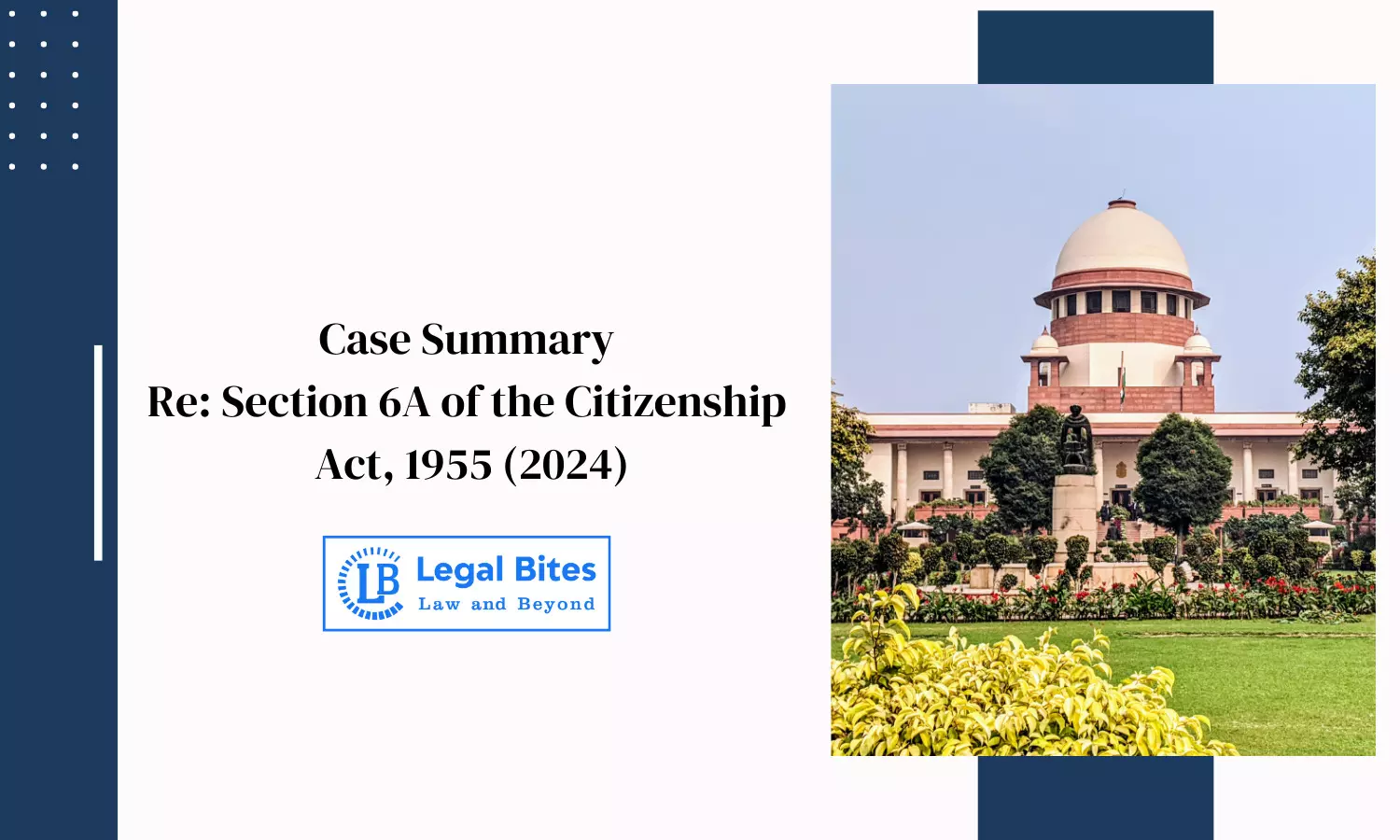Case Summary: Re: Section 6A of the Citizenship Act, 1955 (2024) | Validity of Section 6A of the Citizenship Act, 1955
On October 17, 2024, the Supreme Court, in a 4:1 majority decision, upheld the constitutionality of Section 6A of the Citizenship Act, 1955.

The said case is based on the issue of constitutional validity of Section 6A of the Citizenship Act, 1955. The said section confers citizenship on migrants from Bangladesh to Assam. The issue regarding the constitutionality of the provision was referred to the Constitution Bench in the case of Assam Sanmilita Mahasangha v. Union of India by a two-judge bench. Section 6A is alleged to have a violating impact on Articles 6,7,14, 29 and 355 of the Indian Constitution as claimed by the petitioner.
Case Title: In Re: Section 6A of the Citizenship Act, 1955
Court: Supreme Court of India
Citation: Writ Petition (C) No 274 of 2009
Judges: Dr DY Chandrachud (CJI), Surya Kant, MM Sundresh, JB Pardiwala and Manoj Misra, JJ.
Judgment on: 17-10-2024
Brief Facts
To discuss the judgement, it is imperative to first and foremost understand the structure of Section 6A which is as follows:
- To be deemed as citizens under Section 6A(2), the immigrants must have entered Assam before 1 January 1966.
- Immigrants who entered Assam post 1 January 1966 but before 25 March 1971 and were once detected as foreigners under Section 6A(3), and are registered as citizens are considered to possess citizenship under Section 6A(5). However, in Section 6A(4) no voting rights are given to this category of people for ten years after them being detected as foreigners.
- The third category is those people who entered Assam after 25 March 1971, and they will be considered to be citizens of India as per the Citizenship Act, 1955.
The main argument of the petitioners in this case was the targeting of Assam by inflicting Section 6A. In their opinion, the said provision has encouraged mass immigration in the state, thereby damaging the state’s demographic composition. This was majorly due to granting citizenship to immigrants who merely claimed that they had entered before the 1971 cut-off date. The case was instituted by the petitioners under Article 32 of the Constitution of India to challenge the constitutional validity of the provision.
The case thereby restricts itself to the matter of adjudging the constitutional validity of Section 6A of the Citizenship Act of 1955.
Issues
The following sub-issues arise from the major issue of challenge to the constitutional validity of Section 6A of the Citizenship Act, 1955:
- Whether Parliament had the competence under Article 11 to grant citizenship to migrants from Bangladesh in Assam?
- Whether Section 6A violates Article 14 of the Constitution by targeting Assam and setting unjustifiable cut-off dates.
- Whether Section 6A is violative of Article 355 as it aids in “external aggression” by not curbing undocumented immigration?
- Whether Section 6A violates Article 29(1) by diluting Assamese culture through the induction of migrants from Bangladesh?
- Whether Section 6A should be held unconstitutional merely because of its unreasonable character?
- Whether Section 6A is unconstitutional as it does not provide any implementation method in itself nor does it give any powers to the executive for implementation?
Decision of the Court
Since the case deals with various aspects surrounding the constitutionality of Section 6A of the Citizenship Act, 1955, the analysis of the subject matter is multipronged and can be understood as follows:
A. Parliament’s competence to enact Section 6A
The court performed an in-depth analysis for the purpose of ascertaining the legal regime on citizenship, especially with regards to citizenship status to migrants in the aftermath of India’s partition.
The court post referring to Articles 5,6 and 7 of the Indian Constitution, was able to come to the following inference:
The constitution provides as to who is to be referred to as citizens. This can be understood from the use of the phrase “at the commencement of the Constitution”. Article 6 only covers a limited category of citizens who migrated to India till the date of 26 July 1949, as this is based on the six-month residence requirement. Further, the benefit for citizenship as given to the class that comes under the proviso to Article 7 was dependent on the system of permits as prescribed by law. It was thus only able to cover those people who had remigrated to India from West Pakistan between the period of 1 March 1947 and 26 July 1949. It can thus be understood that both Articles 6 and 7 only confer citizenship on a certain limited class upon the Indian constitution’s commencement.
The court went on to prescribe that Section 6A covers those people who thus do not fall in the above category. It gives citizenship to those who had migrated from Bangladesh to Assam until the cut-off date of 24 March 1971. Thus the court opined that Section 6A does not lead to the amending of Articles 6 and 7.
The court also added that when Article 246 is read with Entry 17 of List 1 of Schedule VII, the Parliament is conferred with powers to enact laws for ‘citizenship, naturalisation and aliens’.
Article 11 was held not to be a non-obstante clause by the court and it remarked that it cannot be artificially read to be non-obstante when the legislative intent to make it so was not present.
B. Unreasonable cut-off dates and singling out of Assam thereby leading to violation of Article 14
In this regard, the court examined the scope of judicial review under Article 14. The court made use of the traditional two-pronged test to check whether the classification was constitutionally permissible. The court stated that there existed no principle that mandates the constitutional validity of under-inclusive provisions to be assessed with judicial deference.
The court traced the existence of Section 6A back to the Assam accord. The Assam Accord was a political settlement that was made between student groups in Assam and the Union of India. The court formulated two yardsticks as stemming out from Section 6A:
i. Entry of migrants in Assam
ii. Entry must be before 25 March 1971
The court mentioned the above cut-off date to be rational on the grounds of the definition of “illegal migrants” in the Illegal Migrants (Determination by Tribunals) Act, 1983, which had already mentioned the same date to be the cut-off. The court thus stated that both yardsticks as stated above were reasonable, had nexus with the object and complied with constitutional principles. Thus Section 6A was not violative of Article 14.
C. Section 6A is violative of Article 355 since aids in “external aggression” by not curbing undocumented immigration
The court dealt with this issue by stating that if a legislative enactment is challenged for contravention of Article 355 of the Constitution, the same can lead to disastrous consequences. Article 355’s duty if converted into right would lead to the handing over of emergency powers in the hands of the courts and citizens. This was nowhere in the legislative intent behind the provision. The whole federal structure of the country could be jeopardized if this is allowed to happen.
The court also mentioned that there cannot be the elevation of Article 355 as an independent ground of judicial review as that is not the purpose of the provision and that if the same is done, it would be against the fundamental principles of the federal structure’s governance.
D. Loss of Assamese cultural identity because of Section 6A thus leading to violation of Article 29(1)
To this, the court observed that the mere presence of different ethnic groups (people from Bangladesh in this case) did not pose any threat to the people of Assam. Article 29(1) grants the right to conserve but it does not do so at the cost of other ethnic groups and people. The court reinstated that the protection and preservation of the cultural and linguistic interests of the people of Assam is being done by statutory as well as constitutional provisions. It is unjustified that the petitioners are using the law to promote that the presence of other ethnic groups of people is jeopardising their cultural interests.
E. Section 6A(3) is unconstitutional on grounds of temporal unreasonableness
While dealing with this issue, the court first reiterated the meaning of temporal unreasonableness for which it stated that this is applicable in cases where the specific enactment when made was reasonable and valid but gradually becomes arbitrary over time.
In this particular case, the court mentioned that the classification made by Section 6A had not become irrelevant in today’s date and thus was still applicable. Thus in such case, it could not be termed to be unconstitutional on grounds of temporal unreasonableness. The objective of the provision still necessitates the classification thus made. Therefore the court refused to make section 6A(3) unconstitutional on grounds of temporal unreasonableness.
F. Section 6A is unconstitutional as it doesn’t provide a method for implementation nor empower the executive to implement the provisions.
The court held Section 6A to be a substantive provision that conferred citizenship on a certain class of persons. Sections 5 and 6 of the Citizenship Act mention that citizenship is to be acquired through registration and naturalisation. They, however, do not provide any express registration process. Registration, however, is not the de facto model of securing citizenship in India.
Thus the use of “deeming fiction” obviated the requirement for registration. The court thus held that Section 6A cannot be held to be unconstitutional because it does not prescribe a procedure for registration.
Thus upon analysing the issue of constitutionality of Section 6A on the basis of the in-depth analysis of the above six sub-issues, the judgement that was passed stated that Section 6A is not unconstitutional.
Click Here to Read the Official Judgment

